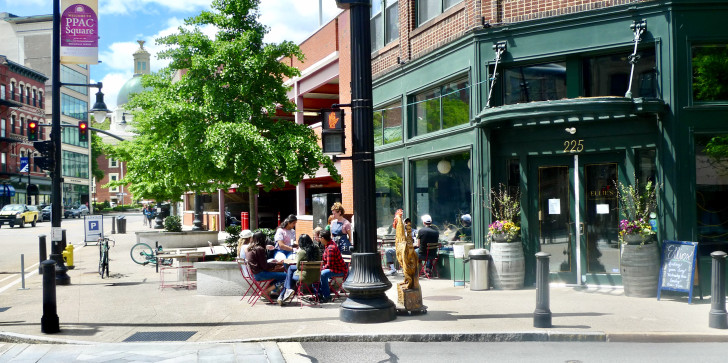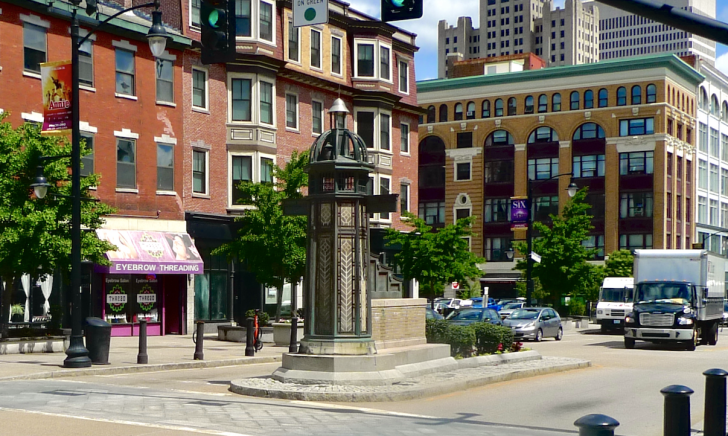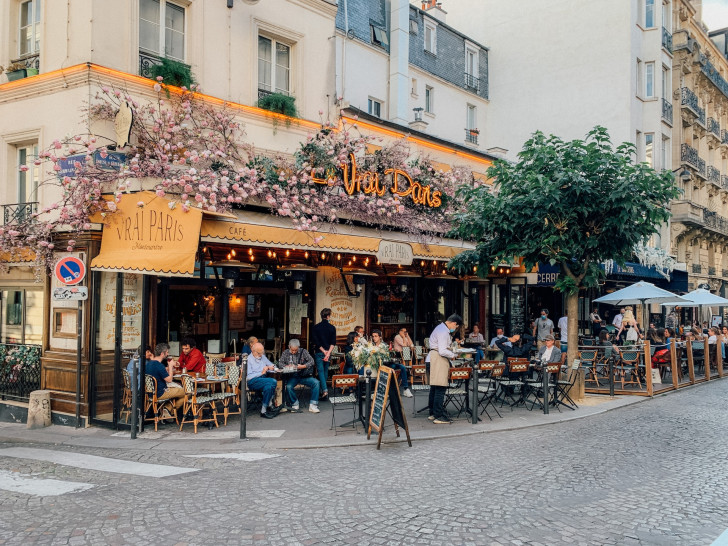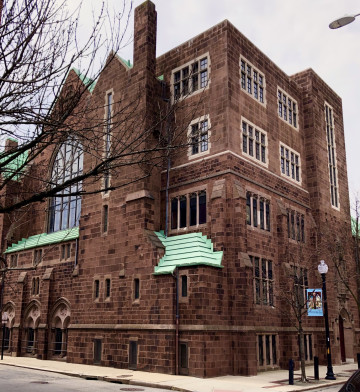PPAC Square: Paris in Providence–Architecture Critic Morgan
Saturday, June 03, 2023
GET THE LATEST BREAKING NEWS HERE -- SIGN UP FOR GOLOCAL FREE DAILY EBLAST
Until seeing the small lamppost banner at the corner of Weybosset and Mathewson Streets, I did not know that there was a place downtown called PPAC Square. The name is uninspired, but the square has the strong urban design elements that make this commercial heart of Providence the place to hang out. While downtown may be struggling–not enough people or housing or parking, this open square reminds us of why the hope for city life is still on the street and not in some mega-structure. We humans thrive best when we freely encounter one another and interact, dine, shop, or conduct business out on the sidewalk or in a congenial space such as a restaurant.
Cities evolve, of course, and four-year-old Ellie’s Café is in the Liggett’s Drug Store that occupied the space for decades. The spirit and the bustle of the earlier store survives, even though the soda fountain is gone. The white subway tile walls reflect lots of sunlight through the plate glass windows, and the whole is reminiscent of a classic New York eatery. (My wife says I like Ellie’s so much because it feels like Greenwich Village or the Upper West Side.) The owner’s intent may have been Parisian, which also works for me, as I believe that a vibrant café society is an indicator the healthy neighborhood.
Like the success of the Seven Stars Bakery on Hope, a place like Ellie’s fosters a sense of community, providing a neutral and appealing place for people to connect. I am happy to sit, watch people, and ponder how successful cities work–one bistro like this can do more to make a downtown livable than a 40-story skyscraper, taking people off the street and isolating them from city life, ever could. It doesn’t take years of graduate study, actuarial tables, or a team of experts to figure out what makes a city work. Chalked on the wall of the former Liggett’s is this statement: Our intimate eatery is inspired by the Parisian way of life, a place where everyone does their own thing for love of it, while cherishing simple pleasures.
Providence isn’t Paris, or Amsterdam or Milan. It might be something better–a smaller, more embraceable experience. We do, nevertheless, have some of the same street furniture, such as bollards and cobblestones (ideal for rearranging into street barricades when students or unions strike). Part of the variety of such urban markers is a former public toilet that looks like the entrance to the Paris Metro. Downtown Providence has lots of buildings that can be read as units of houses–apartments or offices with individual windows, rather than strips of repeated punch-card fenestration. These are windows that a child could look up at and declare, That is where my Daddy/Mommy works.
PPAC Square. The lantern in the center once marked the entrance to an underground toilet. PHOTO: Will Morgan
We often take this kind of townscape for granted, but downtown Providence is contemporaneous with much of the heart of Paris, especially the Right Bank that was largely re-built in the 19th Century. Modern skyscrapers are banished to the edge of the historic city. Part of the success of the City of Light is that development was limited to a six-story height limit.
Ellie’s echoes this Parisian optical store on the Rue de Rivoli in how it wraps around the corner and interacts with the street.
After coffee and a croissant, a stroll will reveal other gems that are not usually on one’s radar. For example, PPAC itself is an exceptional example of the pre-Depression movie palace, so consider the theatre’s Richmond Street front. The lively Spanish Baroque facade is a well-preserved survivor of the work of C.W. and George Rapp, among America’s greatest fantasy palace designers.
Another undiscovered treasure is the parish house at the corner of Mathewson and Chapel Streets. This addition to Grace Church is a work by Ralph Adams Cram, the Gothic Revival architect responsible for much of the Princeton University campus. Seemingly fortified, the castle-like parish house adds a medieval English note to the area’s Parisian ambience.
A good restaurant can be a catalyst for anchoring, even reviving a neighborhood. Instead of leaving the shaping of the city to developers, perhaps we should take our planning cues from a successful downtown restaurateur like Ellie.

GoLocal architecture critic Morgan has an undergraduate degree from Dartmouth and two graduate degrees from Columbia. He has taught at Princeton and at Brown. He likes to remind people that the Ivy League is merely a collegiate athletic conference.
Related Articles
- Can We Make Schools Safe Without Turning Them Into Fortresses? – Architecture Critic Morgan
- Domestic Triumph on Boylston Avenue – Architecture Critic Will Morgan
- Déjà Vu All Over Again: Gano Street Apartments – Architecture Critic Morgan
- New Worker Housing: North Main Street – Architecture Critic Morgan
- Should Architects Run for Office? – Architecture Critic Morgan
- The Edsel of Urban Design — Architecture Critic Will Morgan
- Frank Lloyd Wright in Rhode Island – Architecture Critic Morgan
- Pawtucket Modern–Architecture Critic Morgan
- People on the Move: RISD’s Architecture Head Leaves for London, Culinary Director at Park
- The “New” License Plate and the Race to the Bottom – Architecture Critic Morgan
- A Major Addition to Rhode Island in Newport -– Architecture Critic Morgan
- The Carpenters Union: An Impressive New Home on I-95 – Architecture Critic Morgan
- The Center of the City – Architecture Critic Morgan
- Pawtucket/Central Falls T Station Lacks Design–Architecture Critic Morgan
- Goodbye Fox Point—William Morgan, Architecture Critic
- Old Miriam Hospital Transformed to Elegant Living on Parade St.—Morgan, Architecture Critic
- License Plate Dilemma – Architecture Critic Morgan
- The Elegance of Weed: Mother Earth–Architecture Critic Morgan
- COLLIER: The City’s Coolest Park–Architecture Critic Morgan
- Trader Joe’s: Great Market, Lost Opportunity–Architecture Critic Morgan
- Former Mashpee Wampanoag Tribe Chairman and Top RI Architecture Firm CEO Sentenced in Bribery Case
- Coffee Exchange Redux – Architecture Critic Morgan
- Faltering Fane Tower – Architecture Critic Morgan
- More Storage, Less Livable City – Architecture Critic Morgan








